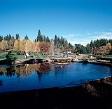Devonian Botanic Garden

The University of Alberta Devonian Botanic Garden began in 1959 with an 80-acre land grant from University alumnus H.A. Dyde, QC. For years, the sand dunes and peat sloughs were home to two oil wells and the land’s native plants. Without a significant budget, progress in the early years was slow, with most effort devoted to burying exposed pipeline associated with the oil wells. In 1974, heavy snows after a wet fall contributed to massive flooding that killed off much of the vegetation.

Friends of the Devonian Botanic Garden, in 1975, targeted fundraising efforts to the reparation of the flood damage. Their efforts attracted $572,405 from the Devonian Foundation, which was matched by a grant from the Department of Advanced Education. The Devonian Foundation asked that Garden be formally known as The University of Alberta Devonian Botanic Garden. With this large grant, the Garden was able to do much more than repair the flood damage. It also purchased an additional 110 acres and built Headquarters Building and greenhouses.

Located 30 kilometres southwest of Edmonton, today the Devonian Botanic Garden is a unit of the Department of Agriculture, Forestry, and Home Economics. It houses a Japanese garden, floral gardens, and native and alpine plants. These plant collections are repositories for plants that have worldwide historical, medicinal, botanical, horticultural, and geographical significance. It has, as its logo, the Himalayan Blue Poppy, which some horticulturalists thought would never grow in Alberta.

The University uses the gardens for teaching as well as for research. Some of the research conducted at the Garden is multidisciplinary and much of it is collaborative. Areas of interest include wetland ecology, the study of mosses, fungi and algae, and the study of alpine and cold-hardy plants. The Garden has a reputation for having a unique northern climate garden. It is open to the public and attracts visitors with general as well as horticultural or academic interests.

The Kurimoto Japanese Garden, occupying five acres, is one of only a few Japanese gardens established in northern latitudes. This open stroll-style garden is designed to harmonize with the natural landforms and vegetation of the site. Each element—from the grassy hills to the streams, ponds, and small waterfall—has been carefully arranged to create an area of peace and quiet for meditation. It offers visitors an opportunity to experience the different sense of space, use of shapes, and foliage basic to Japanese Garden design.
With its extensive trail system through the sand dunes and mixed woodland, the Garden offers amply opportunity to observe fauna as well as flora. The many courses offered at the Garden involve hands-on work in the herb or rock gardens, the two native Alberta plant gardens, the shrub borders, the Iris and Primula dell, and the Japanese garden. In addition, there are a butterfly house and numerous perennial border gardens.
In keeping with the University’s dedication to reaching out to the community, the Devonian Botanic Garden offers a beautiful garden cluster and nature area to tourists, conventions, and major events such as film productions.
For more information, visit the Devonian Botanic Garden's website.